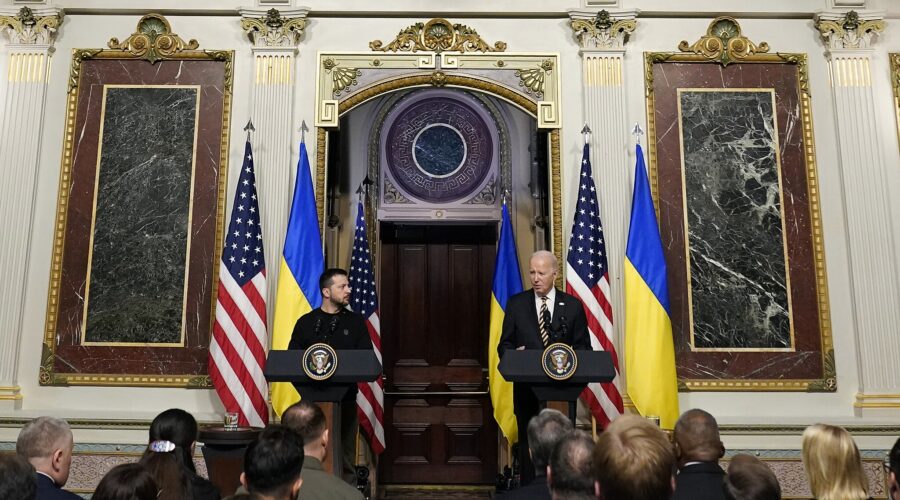After months of stalling, the US House has approved a $61 billion package of foreign aid for Ukraine. The Eastern European nation is expected to get weapons that could help it inflict serious losses on the Russian military. But will that be enough to change the situation on the battlefield in Ukrainian favor?
One of Kyiv’s major problems is its nearly complete dependence on the United States and its allies. Without Western money and weapons, the war-torn country would have been defeated a long time ago. But even though the West provides Ukraine with almost all sorts of weapons, and helps the government in Kyiv preserve social stability at home, the Ukrainian military is far from restoring control over territories Russia has captured over the past two years.
“Weapons are an important factor in war, but not the decisive one; it is man and not materials that counts,” late Chinese leader Mao Tse Tung once said. For Kyiv, Western military aid and mobilization are equally important. But they both seem to be coming too late.
Despite the US aid package, Russia continues to make gains in the Donbass. Although the Russian military is suffering high losses capturing strategically insignificant villages around Bakhmut and Avdiivka, at this point the Ukrainian army does not have the capacity to retake the initiative and stop Russian advances.
For the foreseeable future, Russia will almost certainly continue capturing territory in the Donbass. It seems to be a matter of time before its military seizes Chasiv Yar, and starts approaching the remaining Ukraine-held Donbass cities of Kramatorsk and Sloviansk. Kyiv, however, reportedly fears that Moscow might even attempt to capture Kharkiv – the Eastern European nation’s second largest city.
After Russian Foreign Minister Sergey Lavrov said that Kharkiv had “an important role” in Moscow’s plans to create a demilitarized “sanitary zone” to protect Russian border regions from Ukrainian attacks, in Ukraine and the West speculations began to grow about a potential Russian assault on the city of around 1,4 million people. In order to achieve such an optimistic goal, the Kremlin would have to mobilize hundreds of thousands of new troops – something that does not seem to be on Russian President Vladimir Putin’s agenda at the moment.
That, however, does not mean that Russia will not soon launch an “offensive” reportedly aiming to capture Kharkiv. In reality, however, with the current number of troops in Ukraine, such a military operation will likely be a pure “maskirovka” – a set of procedures designed to confuse and mislead the opponent – while the Kremlin’s top priority, at least at this stage of the invasion, will remain the Donbass. But what will Ukraine do?
A new package of weapons could, to a certain extent, help Kyiv hold out until European countries mobilize their military-industrial complex and provide more military aid to the Ukrainian Armed Forces. Meanwhile, Ukraine is expected to lose more territory, hoping that the US assistance will allow it to gradually consolidate its positions and prepare to launch another counteroffensive either in winter this year, or in the spring of 2025.
While retreating from the Donbass villages and towns, Ukraine will likely strike strategically important facilities and infrastructure deep in Russian territory. It is entirely possible that the Ukrainian military will seek to destroy the Crimean bridge once and for all, regardless of a potential Russian retaliation.
For the next few months, Kyiv will undoubtedly continue to face manpower shortages on the battlefield. Although on April 16 Ukrainian President Volodymyr Zelensky signed into law a controversial mobilization bill aimed at boosting troop numbers, new draftees will require time to train before they can be deployed to fight.
The Ukrainian Ministry of Foreign Affairs’ decision to ban all consular services abroad for men of military age (18 to 60), except for issuing identity cards for returning to Ukraine, perfectly illustrates that Kyiv is struggling to mobilize more troops. Given that the Kremlin does not seem to be particularly willing to declare another wave of “partial mobilization”, sooner or later the conflict could become a stalemate. Such an outcome could allow certain Western political factions to attempt to pressure both sides to sign a ceasefire agreement.
Quite aware of that, Ukraine will likely begin to fight for a better bargaining position. Policy makers in Kyiv know that the West are not giving their country enough weapons to defeat Russia. But Western powers are not allowing Russia to defeat Ukraine either.
That is why Kyiv will have a hard time boosting Ukraine troops’ morale, as people in the Eastern European nation seem to be tired of the war in which both sides are suffering heavy losses.
The Russian population, on the other hand, has never been eager to participate in Putin’s adventure in Ukraine. That is one of the reasons why the Kremlin remains hesitant about announcing a general, or at least another partial mobilization.
Despite fatigue, the Ukrainians, unlike Russians, do not seem to have much choice but to continue fighting, hoping that in 2025 they will manage to recapture significant parts of the territory they lost over the past two years. Whether they will be successful or not will depend on how they conduct the mobilization, as well as on the quantity of weapons they get from the West.
Image: Joe Biden and Volodymyr Zelenskyy at the White House n December 2023 by U.S. Embassy Kyiv Ukraine

